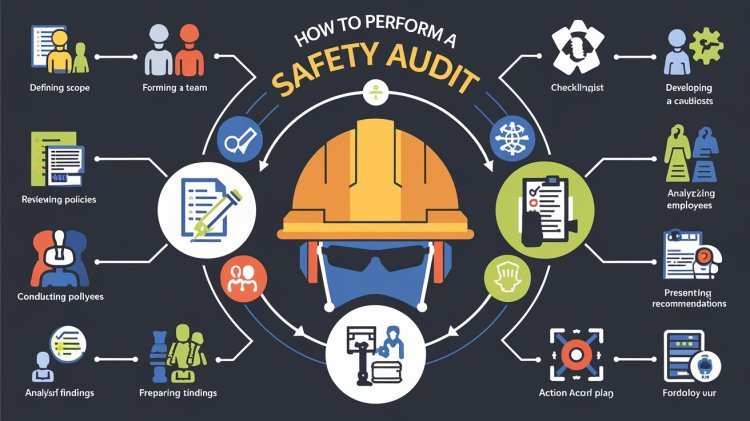How to Perform a Safety Audit: A Step-by-Step Guide
This article details the key steps for conducting a safety audit to ensure workplace safety and compliance. It discusses defining the audit's scope, forming a diverse audit team, reviewing safety policies, developing a checklist, and conducting site inspections and employee interviews. Additionally, it emphasizes analyzing findings, preparing an audit report, presenting recommendations, creating an action plan, and following up for continuous safety improvements.

Safety audits are critical for ensuring regulatory compliance and creating a safe working environment. They assist firms in identifying hazards, assessing risks, and implementing corrective actions. This tutorial will help you through the important steps for conducting an effective safety audit.
What is a Safety Audit?
A safety audit is a systematic assessment of an organization's safety management practices. It evaluates the effectiveness of safety policies, processes, and controls in reducing risks and meeting legal and regulatory requirements.
Steps to Perform a Safety Audit
1. Define the Scope and Objectives
Before you begin the audit, clearly identify its scope and objectives. Decide which areas will be audited, such as specific departments, procedures, or categories of dangers. Setting defined goals helps to concentrate the audit and ensures that all key topics are addressed.
2. Form an Audit Team
Form a team of experts with varied backgrounds, including safety professionals, management representatives, and employees familiar with the processes being audited. A multidisciplinary team brings diverse perspectives, which can improve the audit's efficacy.
3. Review Existing Safety Policies and Procedures
Begin by studying the organization's safety rules, procedures, and previous audit reports. This assessment will help you understand the present safety framework and suggest issues that may require further investigation during the audit.
Request For Sample! https://axonator.com/request-for-demo/
4. Develop an Audit Checklist
Create a comprehensive checklist tailored to the specific scope of the audit. The checklist should include questions and criteria related to:
- Compliance with safety regulations
- Effectiveness of safety training programs
- Availability and use of personal protective equipment (PPE)
- Maintenance and inspection records
- Incident reporting and investigation procedures
5. Conduct the Audit
Now it's time to perform the audit. Follow these steps:
- Site Inspection: Visit the worksite to observe operations, safety practices, and conditions. Look for potential hazards and non-compliance with safety standards.
- Interviews: Speak with employees and management to gather insights about safety practices, training, and incidents. Their perspectives can reveal gaps and areas for improvement.
- Document Review: Examine records, including safety training logs, maintenance records, and incident reports. Ensure that documentation is complete and accurate.
6. Analyze Findings
After collecting data, analyze the findings to identify trends, strengths, and weaknesses in the safety management system. Look for patterns in incidents, compliance issues, and employee feedback.
7. Prepare an Audit Report
Document the audit findings in a clear and concise report. The report should include:
- Summary of the audit process
- Key findings and observations
- Identified strengths and areas for improvement
- Recommendations for corrective actions
8. Present Findings and Recommendations
Share the audit report with management and relevant stakeholders. Present the findings and recommendations in a constructive manner, emphasizing the benefits of addressing identified issues.
9. Develop an Action Plan
Collaborate with management to develop an action plan for implementing the recommended improvements. Assign responsibilities, set deadlines, and allocate resources for each action item.
For More Information! https://axonator.com/blog/how-to-perform-a-safety-audit/
10. Follow Up
After implementing the action plan, schedule a follow-up audit to assess the effectiveness of the changes made. Continuous improvement is vital to maintaining a safe work environment.
Conducting a safety audit is a critical step in assuring workplace safety and compliance. Organizations can use these procedures to detect dangers, enhance safety standards, and build a safe culture. Regular audits protect employees while also improving overall business efficiency.
About Axonator Inc:
At Axonator, Our vision is simple yet powerful: to enable the world on mobile. We envision a future where every aspect of business and society is seamlessly connected through mobile devices. Our mission is to empower businesses worldwide to leverage the full potential of mobile technology, transforming the way they operate, communicate, and collaborate.
Contact:
Axonator Inc. (The World On Mobile)
Austin, TX, USA
USA: +1-716-274-8885
India: +91-8600-032-635
Email: support@axonator.com
Website: https://axonator.com/
What's Your Reaction?

















